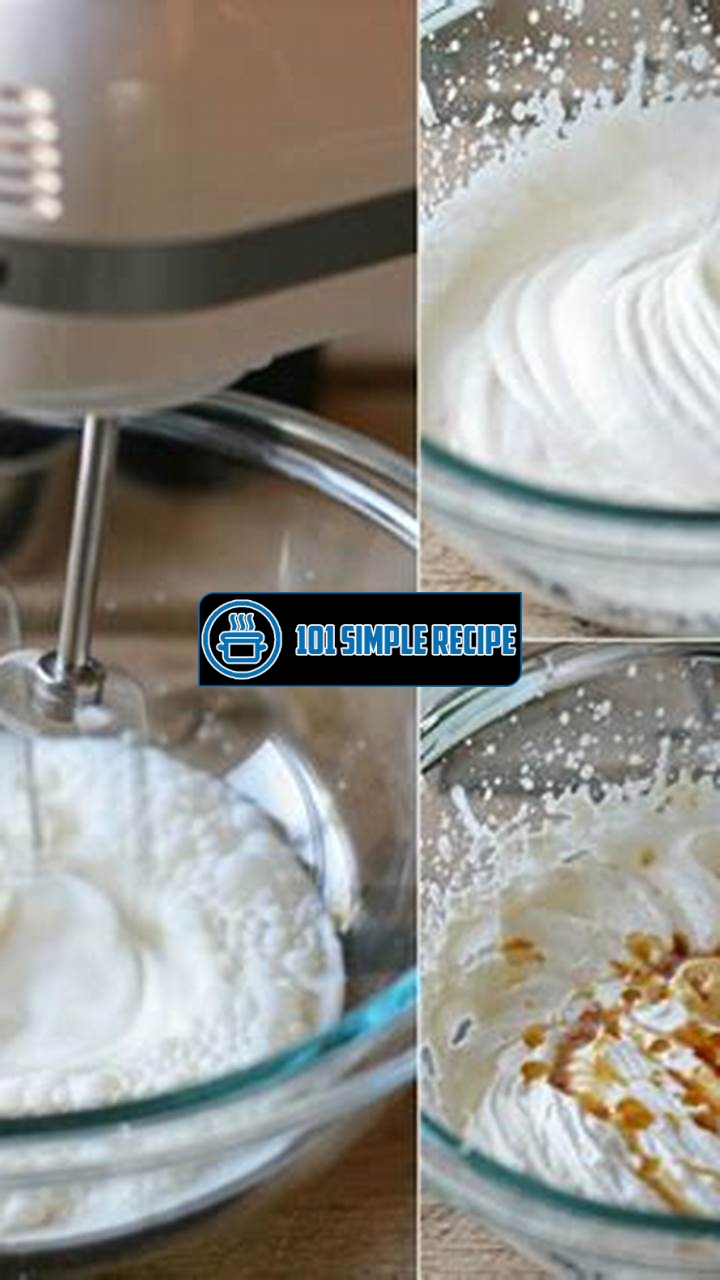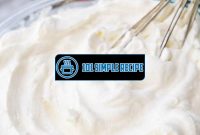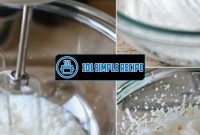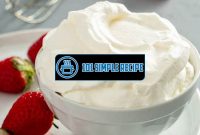Are you craving homemade whipped cream but don’t have heavy cream on hand? Don’t worry, because we’ve got you covered! ✨ Making whipped cream without heavy cream is not only possible but also incredibly easy. Whether you’re lactose intolerant, watching your calorie intake, or simply ran out of heavy cream, there are several alternatives you can use. In this article, we’ll explore various methods and ingredients you can utilize to achieve that delicious, fluffy texture without heavy cream. So let’s dive in and learn how to make whipped cream without heavy cream!

Evaluating Cream Alternatives
When it comes to making whipped cream without heavy cream, there are several alternatives that you can consider. These substitutes are not only convenient but also offer a different taste and texture to your desserts. In this article, we will explore the various options available and help you choose the best cream substitute for your recipe.
Different Types of Cream Substitutes
1. Coconut Cream: One popular cream substitute is coconut cream. It is extracted from the flesh of mature coconuts and has a rich, creamy texture. Coconut cream adds a slight tropical flavor to your desserts, making it an excellent choice for dishes like coconut cream pie or tropical fruit parfait.
2. Cashew Cream: Another alternative is cashew cream, made by blending soaked cashews with water. Cashew cream has a smooth, velvety texture and a mild nutty flavor. It works well in both sweet and savory recipes and can be used in dishes like vegan cheesecake or creamy pasta sauce.
3. Silken Tofu: If you’re looking for a non-dairy option, silken tofu makes a great cream substitute. It has a soft and smooth texture that is perfect for creating a creamy consistency. Silken tofu is ideal for vegan desserts like chocolate mousse or strawberry tofu cream.
4. Greek Yogurt: For those who prefer a tangy taste, Greek yogurt can be used as a cream alternative. It has a thick and creamy texture that works well in desserts like fruit parfaits or frozen yogurt. Greek yogurt also provides additional protein, making it a healthier choice.
Nutritional Considerations for Cream Alternatives
When choosing a cream substitute, it’s essential to consider the nutritional aspects. While heavy cream is rich in fat, substitutes like coconut cream and cashew cream contain healthy fats that offer various health benefits. Additionally, alternatives like silken tofu and Greek yogurt provide protein, which is beneficial for muscle growth and repair. By opting for these substitutes, you can enjoy a guilt-free dessert experience.
Choosing the Best Cream Substitute for Your Recipe
When deciding on the best cream substitute for your recipe, it’s essential to consider the flavor profile and texture you desire. Coconut cream offers a tropical twist, cashew cream adds a nutty richness, silken tofu provides a smooth consistency, and Greek yogurt gives a tangy flavor. Depending on your preference and recipe requirements, you can select the cream alternative that best complements your dish. Experimenting with different substitutes can also lead to unique and delicious creations.
In conclusion, by evaluating the various cream alternatives such as coconut cream, cashew cream, silken tofu, and Greek yogurt, you can make whipped cream without heavy cream and still achieve a delectable result. Consider the nutritional aspects and choose the substitute that suits your taste preferences and recipe needs. So, why not give these alternatives a try and delight your taste buds with a new twist on whipped cream? Happy experimenting!
Whipping Techniques for Non-Dairy Cream
When it comes to making whipped cream without heavy cream, there are several effective techniques you can try to achieve a light and fluffy texture. Whether you have dietary restrictions or simply prefer a non-dairy alternative, these methods will help you create a delicious whipped topping. In this article, we will explore two popular whipping techniques: the bowl and whisk method, and using a handheld or stand mixer. Additionally, we will provide some helpful tips for successfully whipping non-dairy cream. Let’s get started!
Bowl and Whisk Method
If you don’t have a mixer at hand, the bowl and whisk method can save the day. Start by chilling a metal bowl and the whisk in the freezer for about 15 minutes. This will help keep the non-dairy cream cold, which is essential for achieving the desired texture. Once chilled, remove the bowl and whisk from the freezer and pour the non-dairy cream into the bowl.
Gently begin whisking the cream in a circular motion, gradually increasing the speed as it thickens. It may take a bit longer compared to using a mixer, but with some patience, you will begin to notice soft peaks forming. These soft peaks are the indication that the non-dairy cream is being whipped to perfection.
Important: Be cautious not to overbeat the non-dairy cream, as it can quickly turn into a grainy consistency. Keep a close eye on the texture and stop whisking once soft peaks form.
Using a Handheld or Stand Mixer
If you have access to a handheld or stand mixer, this method will provide a quicker and more efficient way to whip non-dairy cream. First, ensure that the mixing bowl and the whisk attachment are clean and dry. They should be completely free of any moisture, as even a small amount can affect the whipping process.
Next, pour the non-dairy cream into the mixing bowl. Start the mixer on low speed and gradually increase it to medium-high. As the non-dairy cream whips, you will notice it thickening and soft peaks beginning to form. This process typically takes around 3-5 minutes, but keep an eye on the texture to avoid overwhipping.
Note: It’s important to use the appropriate speed setting on your mixer according to the manufacturer’s instructions. This will ensure proper aeration and prevent the non-dairy cream from curdling or becoming grainy.
Tips for Successfully Whipping Non-Dairy Cream
Now that you are familiar with the whipping techniques, let’s explore some tips to ensure outstanding results when making whipped cream without heavy cream. These tips will help you achieve a light and fluffy texture every time.
- Chill the non-dairy cream: Similar to heavy cream, chilling the non-dairy cream before whipping will help it hold its shape and aerate more effectively. Place it in the refrigerator for at least an hour before starting the process.
- Choose the right non-dairy cream: Different brands and types of non-dairy creams may yield varying results. Experiment with different options to find one that works best for whipping.
- Add flavorings: Enhance the taste of your whipped non-dairy cream by incorporating various flavorings such as vanilla extract, cocoa powder, or fruit puree.
- Use a stabilizer: To improve the stability of your whipped cream, consider adding a stabilizer like agar agar or cornstarch. These ingredients help maintain the desired texture for a longer period.
By implementing these tips and utilizing the appropriate whipping technique, you can enjoy light and fluffy whipped cream without heavy cream. So go ahead and indulge in your favorite desserts with this delightful non-dairy alternative!
Enhancing Flavor and Texture
When it comes to making whipped cream without heavy cream, there are several creative ways to enhance the flavor and texture of your alternatives. By exploring different ingredients and techniques, you can create a delicious and satisfying whipped cream substitute. In this article, we will discuss some of the best methods to improve the taste and consistency of your homemade whipped cream.
Adding Sweeteners and Flavorings
One of the key elements in making whipped cream without heavy cream is finding the right sweeteners and flavorings to enhance the taste. While heavy cream provides a natural sweetness, you can achieve similar results by using substitutes like powdered sugar, maple syrup, or honey. These sweeteners not only add a touch of sweetness but also infuse unique flavors into your whipped cream.
Furthermore, you can experiment with different flavorings to create a variety of whipped cream alternatives. Vanilla extract is a classic choice, but you can also try using almond extract, mint extract, or even citrus zest to add an extra dimension to your whipped cream. These flavorings will not only make your whipped cream taste more interesting but also complement the other ingredients in your dessert.
Incorporating Stabilizers for Long-lasting Whipped Cream
If you want your whipped cream to last longer, incorporating stabilizers is essential. Stabilizers help maintain the whipped texture and prevent the cream from deflating or becoming watery. One of the most common stabilizers is gelatin. By dissolving gelatin in warm water and adding it to your whipped cream mixture, you can achieve a stable and long-lasting result.
Another option is using cornstarch. Mixing a small amount of cornstarch with your sweeteners before adding them to the whipped cream will help thicken and stabilize the mixture. This will ensure that your whipped cream maintains its shape and texture for a longer period of time.
Additionally, you can also consider using cream of tartar as a stabilizer. Cream of tartar is an acidic powder that helps stabilize the whipped cream by increasing its volume and preventing over-whipping. By combining cream of tartar with your flavorings and sweeteners, you can achieve a light and fluffy whipped cream that holds its shape for hours.
Achieving the Perfect Consistency
Lastly, achieving the perfect consistency is crucial in making whipped cream without heavy cream. The key is to find the right alternative ingredient that will mimic the texture of heavy cream. One option is using coconut cream, which contains a high fat content and provides a creamy, smooth consistency.
Another popular alternative is using aquafaba, which is the liquid from canned chickpeas. Aquafaba has a similar consistency to egg whites and can be whipped to achieve a light and fluffy texture. By adding sweeteners and flavorings to aquafaba, you can create a delicious vegan whipped cream that is both smooth and creamy.
Overall, making whipped cream without heavy cream is not only possible but also offers a chance to explore unique flavors and textures. By experimenting with different sweeteners, flavorings, stabilizers, and alternative ingredients, you can create a whipped cream substitute that suits your taste preferences and dietary needs.
Recipes for Homemade Whipped Cream Substitutes
Are you craving for a luscious dollop of whipped cream but don’t have any heavy cream on hand? Don’t worry, we’ve got you covered! In this article, we will share with you some easy-to-follow recipes for making whipped cream without heavy cream. With just a few simple ingredients, you can indulge in the creamy goodness of homemade whipped cream substitutes. So, let’s dive in and explore these delightful alternatives!
Coconut Milk Whipped Cream
Coconut milk is a versatile ingredient that can be used as a delightful substitute for heavy cream in whipped cream recipes. Not only does it offer a rich and creamy texture, but it also adds a subtle tropical flavor to your desserts. To make coconut milk whipped cream, follow these steps:
- Chill a can of full-fat coconut milk in the refrigerator overnight. This will help separate the cream from the liquid.
- Open the can and carefully scoop out the solidified coconut cream into a mixing bowl.
- Add a sweetener of your choice, such as powdered sugar or maple syrup, to the bowl.
- Using an electric mixer or a whisk, beat the coconut cream until it thickens and forms soft peaks.
- Voila! Your homemade coconut milk whipped cream is ready to be enjoyed. Use it to top your favorite desserts or hot beverages.
Remember to use full-fat coconut milk for the best results, as the fat content is necessary for achieving the desired whipped consistency.
Avocado Whipped Cream
For a creamy and nutritious alternative to heavy cream, avocado whipped cream is an excellent choice. Avocado adds a smooth and velvety texture to your whipped cream, making it a satisfying and healthier option. Here’s how you can make avocado whipped cream:
- Cut a ripe avocado in half, remove the seed, and scoop out the flesh into a blender or food processor.
- Add a sweetener of your choice, such as honey or agave syrup, to the blender. The amount will depend on your desired level of sweetness.
- Blend the avocado and sweetener until smooth and creamy.
- If the consistency is too thick, you can add a small amount of milk or creamer to achieve the desired texture.
- Marvel at your velvety green avocado whipped cream! Use it as a scrumptious topping for your desserts, pancakes, or fruit salads.
Avocado whipped cream not only satisfies your sweet tooth but also provides healthy fats and nutrients that are beneficial for your body.
Aquafaba-Based Whipped Cream
Have you ever heard of aquafaba? It’s the liquid that’s left behind after cooking chickpeas, and astonishingly, it can be whipped into a light and fluffy cream! Aquafaba-based whipped cream is a perfect vegan alternative to heavy cream. Here’s how you can make it at home:
- Drain a can of chickpeas and collect the liquid, also known as aquafaba, in a mixing bowl.
- Add a sweetener, such as granulated sugar or vanilla extract, to the bowl.
- Using an electric mixer, whisk the aquafaba mixture on high speed until it thickens and forms stiff peaks.
- Indulge in the miraculous transformation of aquafaba into a fluffy whipped cream. You can use it to decorate cakes, top pies, or enjoy it as a light and airy dessert on its own.
✨ Aquafaba is a magical ingredient that allows you to create dairy-free whipped cream that rivals the traditional version in taste and texture.
Now that you know these fantastic alternatives to heavy cream, go ahead and try making whipped cream without heavy cream using coconut milk, avocado, or aquafaba. These recipes are simple and guarantee a delectable whipped cream experience. Enjoy your homemade whipped cream substitutes and get creative with decorating your favorite desserts!
Usage and Storage of Whipped Cream Alternatives
When it comes to making whipped cream without heavy cream, there are a variety of alternatives available. Whether you’re lactose intolerant, following a vegan diet, or simply looking to try something different, non-dairy whipped cream substitutes can be a great option to consider. However, it’s important to understand how to properly use and store these alternatives to ensure their freshness and quality. In this section, we’ll explore the shelf life and best practices for using and storing non-dairy whipped cream substitutes.
Proper Refrigeration and Freezing Techniques
One of the key factors in maintaining the quality of whipped cream alternatives is proper refrigeration and freezing techniques. Just like traditional whipped cream, these substitutes should be stored in the refrigerator to keep them fresh for longer periods. It is recommended to place the container in the coldest part of your fridge, such as the back shelf. This will help maintain a consistent temperature and prevent any spoilage.
If you find yourself with more non-dairy whipped cream alternative than you can use within a few days, freezing is an option. Before freezing, transfer the cream to an airtight container or freezer-safe bag. It’s important to note that the texture may change slightly once thawed, but it can still be used as a topping for various desserts and drinks.
Recommended Serving Times and Temperature
To ensure the best taste and texture, it’s important to serve non-dairy whipped cream alternatives at the appropriate times and temperatures. Like traditional whipped cream, these substitutes are best served chilled. It is recommended to keep them in the refrigerator until just before serving. This will help maintain their firmness and prevent melting.
When it comes to serving times, it’s best to add the non-dairy whipped cream alternative to your desserts or drinks right before serving. This will help retain its light and fluffy texture and prevent any excessive softening or melting. Remember, presentation is key, and serving the cream at the right time and temperature will ensure a delightful dining experience.
Utilizing Leftovers in Other Recipes
If you find yourself with leftover non-dairy whipped cream alternative, don’t let it go to waste! There are numerous creative ways to utilize these leftovers in other recipes. For example, you can add it to your morning coffee or hot cocoa to create a creamy and delectable beverage. It can also be used as a topping for pancakes, waffles, or fruit salads.
Another great way to use leftover non-dairy whipped cream alternative is by incorporating it into desserts such as pies, cakes, or trifles. It can add a smooth and airy texture to these sweet treats. Get creative and experiment with different flavor combinations to elevate your desserts even further.
Remember, non-dairy whipped cream alternatives can be just as delicious and versatile as traditional whipped cream. By following proper storage techniques, serving at the right times and temperatures, and using leftovers creatively, you can enjoy the lusciousness of whipped cream without heavy cream. Start exploring these alternatives today and enhance your culinary adventures!
Frequently Asked Questions
Here are some frequently asked questions about making whipped cream without heavy cream:
| No. | Questions | Answers |
|---|---|---|
| 1. | Can I make whipped cream without heavy cream? | Yes, you can make whipped cream without heavy cream by using alternative ingredients such as coconut cream, milk, or yogurt. These substitutes can provide a similar texture and taste to traditional whipped cream. |
| 2. | How do I make whipped cream with coconut cream? | To make whipped cream with coconut cream, refrigerate a can of full-fat coconut milk overnight. Open the can and scoop out the creamy layer on top. Whip it with a mixer until it reaches a fluffy consistency. Add sweetener and vanilla extract to taste. Voila, you have coconut whipped cream! |
| 3. | Can I use regular milk for whipped cream? | Yes, you can use regular milk to make whipped cream by adding an ingredient like gelatin or cornstarch to stabilize it. However, the texture may not be as thick and creamy as traditional whipped cream. |
| 4. | What is the ratio of yogurt to make whipped cream? | To make whipped cream with yogurt, you’ll need approximately 1 cup of yogurt for every 1 cup of heavy cream called for in the recipe. Make sure to strain the yogurt beforehand to remove excess liquid and enhance its creaminess. |
| 5. | Can I use almond milk for whipped cream? | Almond milk is not the ideal choice for making whipped cream, as it lacks the necessary fat content to achieve the desired texture. It is best to use alternatives like coconut cream or yogurt for non-dairy whipped cream. |
| 6. | Can I freeze homemade whipped cream? | Yes, you can freeze homemade whipped cream. Simply transfer it to an airtight container and place it in the freezer. When you’re ready to use it, thaw it in the refrigerator and give it a quick whisk to restore its fluffy texture. |
Thanks for Reading!
We hope you found these tips helpful in making whipped cream without heavy cream. Whether you’re lactose intolerant, out of heavy cream, or simply looking for a healthier alternative, these substitutes can satisfy your whipped cream cravings. Remember to experiment and find the substitute that suits your taste preferences best. Don’t forget to bookmark this page for future reference and check back often for more exciting recipes and kitchen hacks. Happy whipping!
Jump to Recipe
Whipped Cream Without Heavy Cream

Learn how to make delicious whipped cream without using heavy cream. Perfect for those who are lactose intolerant or looking for a healthier alternative.
- 1 can of coconut cream
- 2 tbsp powdered sugar
- 1 tsp vanilla extract
- Place a can of full-fat coconut cream in the refrigerator overnight.
- Open the can and scoop out the thick, creamy layer of coconut cream that has solidified on top.
- Transfer the coconut cream to a mixing bowl and whip it using an electric mixer until it becomes light and fluffy.
- Add powdered sugar and vanilla extract to the whipped coconut cream. Continue to whip until well combined.
- Transfer the whipped coconut cream to a serving bowl or use it to top your favorite desserts. Enjoy!






